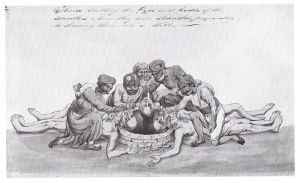
A group of Thugs stabbing the eyes of recently murdered travelers, prior to throwing them into the well. Artist unknown, 1830’s.
The place is India, in the era of the British Raj.
Imagine traveling on a dark road. You and some traveling companions are making your way to a distant city. Perhaps you’re a merchant with wares to sale. The roads are dangerous, especially at night, and there’s safety in numbers. Your party allows yet another fellow traveler into your caravan, someone unknown to you. It’s not an uncommon occurrence in your day. After a few days on the road together, after your confidence is gained, it strikes. You never see it coming. Strangled. Mutilated. Dumped in a well or a shallow grave. Nothing is ever seen or heard of you again.
The event described above was a creation of mine. An event that never happened, yet happened 1,000 times…and 1,000 times again. The perpetrator of the crime was a member of the Thuggee cult, which incidentally gave the English language the word thug. They were feared by all and the extent of their crimes may never be known. Thug Behram, a leader of the cult during the early 1800’s, claimed to have murdered 125 men with his own hands, while attending to a total of 931 murders! If the latter total were correct, it could be claimed that Behram were the most prolific serial killer in history.



